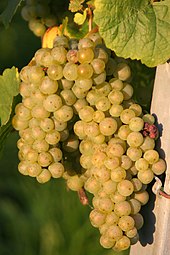Rieslaner
Rieslaner is a white wine variety . The new breed is a cross between Riesling and Silvaner from 1921, which was bred by August Ziegler at the Bavarian State Institute for Viticulture and Horticulture in Veitshöchheim near Würzburg ; a wine barrel in the wine cellar of the Würzburg residence commemorates the researcher. After the turmoil of the Second World War , the variety was bought in 1950 by the "passionate vine grower" Hans Breiderrediscovered. It was he who, through his vehement commitment, ensured that the Rieslaner was widely planted. The entry in the list of varieties took place in 1957. In 1968 it was released for cultivation in Franconia and the Palatinate . In the meantime, the information provided by the breeder about the parents of the crosses has been confirmed by DNA analysis.
Even today the Rieslaner is mainly grown in Franconia (Fürstlich Castell'sches Domainamt, Weingut Geiger und Söhne, Bürgerspital-Weingut, Juliusspital-Weingut, Weingut Kirch, Weingut Reiss, Trockene Schmitts, Weingut Alois Martin, Weingut Arnold, Weingut Luckert), but in addition also in the Pfalz (Winery Probsthof Neustadt-Haardt, Winery Weegmüller, winery Müller-Catoir, Winery Lothar Hagenbuch, Weingut Bernhard Koch) the Rieslaner prone to high acidity , so it is often in normal years only as late or selection offered , but in particularly good years with a sunny autumn it can often produce exceptionally good wines even in the Kabinett quality level . In terms of smell and taste, the fruit is sometimes reminiscent of citrus fruits, with higher quality often of passion fruit , with fully ripe to overripe grapes, of peach, mango, cactus fruit and kiwano.
Because of its present acidity, the Rieslaner is often used as a base wine for sparkling wine . The Rieslaner served as a cross partner of the new breeds Albalonga and Fontanara . With the Optima , the question is still open. The research institute in Geisenheim does not give any references to the Rieslaner, but to an unspecified Riesling x Silvaner crossing. For a long time, the Mariensteiner variety was also considered a cross between Silvaner and Rieslaner. This information from Hans Breider had to be corrected in the meantime.
See also the article Viticulture in Germany and the list of grape varieties .
Synonyms: Main Riesling - but is uncommon
Parentage: Silvaner x Riesling
Ampelographic varietal characteristics
In ampelography , the habitus is described as follows:
- The shoot tip is open. It is hairy like a cobweb. The bronze-colored young leaves are almost hairless.
- The medium-sized leaves are three- to five-lobed and hardly curved. The stem bay is closed in a V-shape. The blade is bluntly serrated. The teeth are set medium-wide compared to other grape varieties.
- The cone-shaped grape is medium-sized, shouldered and dense berries. The round berries are small to medium-sized and green-yellow in color. The juicy berries have a neutral taste.
The grape variety ripens approx. 15-20 days after the Gutedel and is therefore almost still ripening early in international comparison. In the German growing areas, however, it is one of the late-ripening varieties.
The variety is hardly susceptible to powdery mildew and downy mildew and has little tendency to trickle . In wet years, the berries are often attacked by the raw rot. In addition, the variety is prone to stalk paralysis . In the event of an infection with the stickworm- transmitted brushwood disease , the crop failure is greater than the average compared to other grape varieties.
distribution
The vineyards in Germany are distributed among the individual growing areas as follows:
| Wine region | Vineyards (hectares) |
| Ahr | - |
| to bathe | 1 |
| Francs | 42 |
| Hessian mountain road | - |
| Middle Rhine | - |
| Moselle | below 0.5 |
| Near | below 0.5 |
| Palatinate | 37 |
| Rheingau | 1 |
| Rheinhessen | 4th |
| Saale-Unstrut | - |
| Saxony | below 0.5 |
| Stargarder Land | - |
| Württemberg | below 0.5 |
| TOTAL Germany 2007 | 85 |
Source: Vineyard statistics from March 13, 2008, Federal Statistical Office , Wiesbaden 2008 in Descriptive Variety List of the Federal Variety Office 2008, p. 198 ff.
Individual evidence
- ↑ Erika Maul, Fritz Schumann, Bernd HE Hill, Frauke Dörner, Heike Bennek, Valérie Laucou, Jean-Michel Boursiquot, Thierry Lacombe, Eva Zyprian, Rudolf Eibach, Reinhard Töpfer: Focus on the crossing parents of German new varieties of vines - what does the genetic fingerprint say. In: German Viticulture Yearbook. Vol. 64, 2013, ISSN 0343-3714 , pp. 128-142.
- ↑ Horst Diedrich Mohr (Ed.): Color atlas diseases, pests and beneficial insects on the grapevine. 2nd, revised and expanded edition. Eugen Ulmer, Stuttgart 2012, ISBN 978-3-8001-7592-5 .
- ↑ Descriptive list of varieties of the Federal Plant Variety Office 2008 (PDF; 519 kB).
Web links
- Rieslaner in the database Vitis International Variety Catalog of the Institute for Vine Breeding Geilweilerhof (English)
literature
- Horst Dippel (founder): The wine dictionary (= Fischer. 15867). Continued by Cornelius Lange and Fabian Lange . Completely revised and supplemented new edition. Fischer-Taschenbuch-Verlag, Frankfurt am Main 2003, ISBN 3-596-15867-2 .
- Dagmar Ehrlich : ABC of grape varieties. Vines and their wines. Hallwag, Munich 2005, ISBN 3-7742-6960-2 .
- Pierre Galet : Dictionnaire encyclopédique des cépages. Hachette, Paris 2000, ISBN 2-01-236331-8 .
- Walter Hillebrand, Heinz Lott, Franz Pfaff: Paperback of the grape varieties. 13th, revised edition. Fachverlag Fraund, Mainz 2003, ISBN 3-921156-53-X .
- Jancis Robinson : The Oxford Wine Lexicon. 3rd, completely revised edition. Hallwag, Munich 2007, ISBN 978-3-8338-0691-9 .
- Jancis Robinson, Julia Harding, José Vouillamoz : Wine Grapes. A complete Guide to 1,368 Vine Varieties, including their Origins and Flavors. Ecco, New York NY 2012, ISBN 978-0-06-220636-7 .
